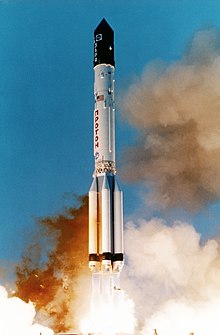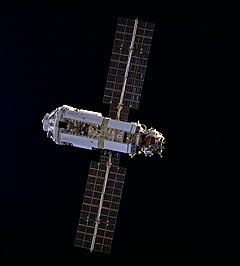|
Zarya (ISS module)
 Zarya (Russian: Заря, lit. 'Sunrise'[c]), also known as the Functional Cargo Block (Russian: Функционально-грузовой блок), is the inaugural component of the International Space Station (ISS). Launched on 20 November 1998 atop a Proton-K rocket, the module would serve as the ISS's primary source of power, propulsion, and guidance during its early years. As the station has grown, Zarya's role has transitioned primarily to storage, both internally and in its external fuel tanks.[4] A descendant of the TKS spacecraft used in the Salyut programme, Zarya was built in Russia but its construction was financed by the United States. Its name, meaning "sunrise," symbolizes the beginning of a new era of international space cooperation.[5] ConstructionThe Zarya design was originally intended as a module for the Russian Mir space station, but was not flown as of the end of the Mir program. A FGB cargo block was incorporated as an upper stage engine into the Polyus spacecraft, flown (unsuccessfully) on the first Energia launch.[6] With the end of the Mir program, the design was adapted to use for the International Space Station. The Zarya module is capable of station keeping and provides sizable battery power; it was suggested to have initially been built to both power and control the recoil from a further derivation of the then classified Skif laser system/Polyus satellite. Commentators in the West thought that the Zarya module was constructed more cheaply and lifted to orbit faster than should have been possible in the post-Soviet era, and that the FGB might have been largely constructed from mothballed hardware from the Skif laser program (which had been canceled after the failed 1987 Polyus launch).[7] The research and development of a similar design was paid for by Russia and the Soviet Union; the design of the module and all systems are Soviet/Russian. The United States funded Zarya through the U.S. prime contracts in the 1990s as the first module for ISS, and it was built from December 1994 to January 1998 in Russia at the Khrunichev State Research and Production Space Center (KhSC) in Moscow.[8] The module was included as part of NASA's plan for the International Space Station (ISS) instead of Lockheed Martin's "Bus-1" option because it was significantly cheaper (US$220 million vs. $450 million). As part of the contract, Khrunichev constructed much of an identical module (referred to as "FGB-2") for contingency purposes. FGB-2 was proposed to be used for a variety of projects; it has been used to construct the Russian Multipurpose Laboratory Module Nauka.[9]  DesignZarya has a mass of 19,323 kilograms (42,600 lb), is 12.56 meters (41.2 ft) long and 4.11 meters (13.5 ft) wide at its widest point. The module has three docking ports: one axially on the front end at the docking sphere, one on the Earth-facing side (nadir) of the docking sphere and one axially on the aft end. Attached to the forward port is the Pressurized Mating Adapter PMA-1, which in turn is connected to the Unity Module – this is the connection between the Russian Orbital Segment (ROS) and the US Orbital Segment (USOS). Attached to the aft port is the Zvezda Service Module. The lower port (nadir) was initially used by visiting Soyuz spacecraft and Progress spacecraft to dock to the ROS; The Rassvet module is now docked semipermanently on the nadir port of Zarya, and visiting spacecraft use Rassvet's nadir docking port instead.[10] It was planned to install another zenith docking port in the docking sphere, however, after the design was changed, a spherical cover was welded in its place.[11] Zarya has two solar arrays measuring 10.67 by 3.35 meters (35.0 by 11.0 ft) and six nickel-cadmium batteries that can provide an average of 3 kilowatts (4.0 hp) of power – the solar arrays have been however partially retracted[12] so the P1/S1 radiators of the Integrated Truss Structure could deploy. They are still generating some power, but not the average 3 kilowatts (4.0 hp) of power, they once provided when they were fully unfurled.[13] Zarya has 16 external fuel tanks that can hold up to 6.1 tonnes (13,000 lb) of propellant (this requirement was mandated by NASA in early 1997 over concerns that the Zvezda Service Module would be further delayed, hence the FGB had to be capable of independent propellant storage and transfer from Progress spacecraft even without Zvezda [14]). Zarya also has 24 large steering jets, 12 small steering jets, and two large engines that were used for reboost and major orbital changes; with the docking of Zvezda these are now permanently disabled. Since they are no longer needed for Zarya's engines, Zarya's propellant tanks are now used to store additional fuel for Zvezda. Launch and flight Zarya was launched on 20 November 1998 on a Russian Proton rocket from Baikonur Cosmodrome Site 81 in Kazakhstan to a 400 km (250 mi) high orbit with a designed lifetime of at least 15 years. After Zarya reached orbit, STS-88 launched on 4 December 1998 to attach the Unity module. Although only designed to fly autonomously for six to eight months, Zarya was required to do so for almost two years due to delays to the Russian Service Module, Zvezda. Zvezda was finally launched on 12 July 2000, docking with Zarya on 26 July 2000. Zarya passed the 50,000-orbit mark at 15:17 UTC on 14 August 2007 during the STS-118 mission to the International Space Station. Dockings
Gallery
Notes
References
See also
|
||||||||||||||||||||||||||||||||||||||||||||||||||








